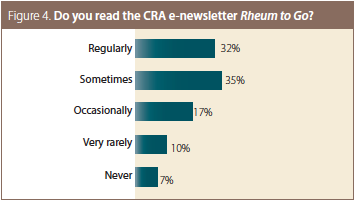Fall 2017 (Volume 27, Number 3)
Survey Results on CRA Communications
"The single biggest problem in communication is the illusion that it has taken place."
– George Bernard Shaw
Download PDF
The mission of the Canadian Rheumatology Association (CRA) is to represent Canadian rheumatologists and promote the pursuit of excellence in arthritis and rheumatic disease care, education and research. As a nationally and internationally respected organization, we serve as a national voice for practicing rheumatologists and researchers with an interest in rheumatic diseases. Like any successful organization, success in fulfilling this mandate depends on how effectively we are able to communicate with our members. To that end, for this quarter’s Joint Count section, we conducted a survey on communications as it relates to the organization and our members. The emphasis was on feedback about the website, rheum.ca; e-newsletter, Rheum to Go; and The Journal of the Canadian Rheumatology Association (CRAJ). A total of 133 responses were received out of the 541 surveys that were sent to members, representing a 33% response rate.
The first question asked members whether they used the CRA website to obtain information (see Figure 1). Half of respondents replied that they referred to the website occasionally, as needed. Only 5% indicated that they never referred to the website, and 14% indicated that they rarely used it. Asked to specify their reasons, some indicated that they did not know what was available on the website and did not find it user-friendly. A few commented that they were not sure what information was available that would be beneficial to their practice.

The next question asked members to evaluate the navigation of the website: 87% of users found the CRA website easy to navigate (Figure 2). We're also trying to make this even better as we launch a new website this fall.

According to the survey, the most popular sections of the CRA website include the Membership Renewal section (79%); the Events section (i.e., information related to the Annual Scientific Meeting [ASM] and Canada Night) (76%); the Membership Directory (52%); and Guidelines and Position Papers (see Figure 3 for more details). One commenter, ostensibly surprised, remarked that they “did not know that careers and jobs were posted on the website!”

When probed as to what additional information they would like to see on the CRA website, many survey respondents explained that they would like to see more clinical and educational resources, such as guidelines, clinical case discussions, and disease and drug information handouts for patients. Other suggestions included more resources for Royal College Section 3 credits, information on funding opportunities for publications, European rheumatology news, and a link to the Journal of Rheumatology (JRheum) along with a JRheum community forum. Given that many of these resources are already available on the website, we must find a way to let our members know and make these more accessible.
CRA members were also asked to provide feedback on the CRA e-newsletter, Rheum to Go. Thirty-two percent of respondents indicated that they read Rheum to Go regularly and another 35% responded that they sometimes read the e-newsletter (Figure 4). Those who responded that they rarely or never read it were asked to specify why. Many of these members cited a lack of time and too many other things to read as reasons for not reading this specific e-newsletter.

The survey then asked how often members would like to receive Rheum to Go, which is disseminated on a bi-monthly schedule. More than half of the survey takers indicated that they would like to receive Rheum to Go bi-monthly (as they do now) and another 37% replied that they would prefer a monthly update.
Finally, the survey also asked questions regarding this journal, The Journal of the Canadian Rheumatology Association (CRAJ). When members were asked if they read the CRAJ, more than half of those surveyed indicated that they read it regularly. A further 22% replied that they read it sometimes and 18% indicated that they read it occasionally (see Figure 5). Those who never or rarely read it specified a lack of time as their main reason for not reading it.

Regarding whether CRAJ readers prefer the electronic or print medium, the split was fairly balanced with 31% showing a preference for the electronic version, 33% reading the print copy, and 36% opting for both the electronic and print versions (see Figure 6).

The last question asked for overall comments on any aspects of the CRA’s communications. While these were varied, one suggested not sending frequent e-blasts about minor issues, explaining that it “then becomes an annoyance rather than helpful communication.” Other respondents were ostensibly content with the status quo. Other communication tools that members indicated they would find useful are listed in Figure 7.

In summary, while members appreciate the website and e-newsletter, there is always room for improvement. The CRA will carefully evaluate the results of this survey, particularly the comments, and strive to update and improve their communications for the benefit of all members.
If you have any other feedback or comments, you are encouraged to contact Claire McGowan at claire@rheum.ca. For feedback on the CRAJ, you are welcome to contact Jyoti Patel at jyotip@sta.ca.
|




